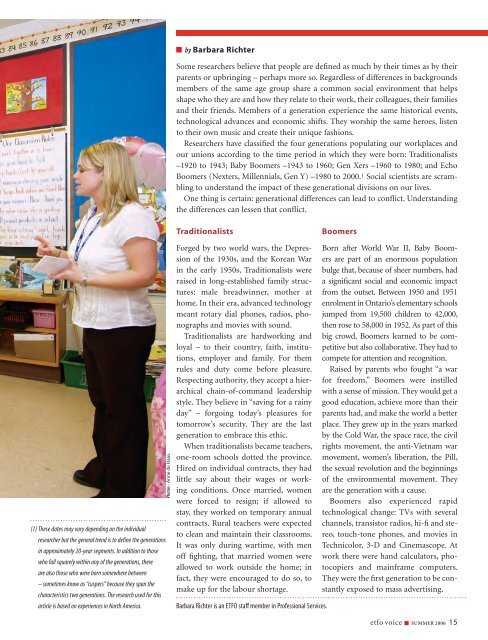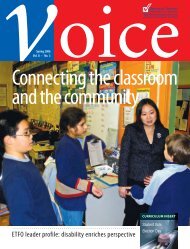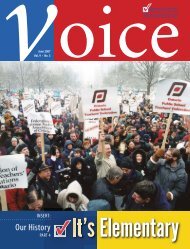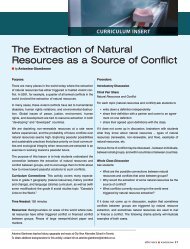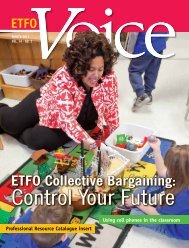Summer 2006 - The member magazine of the Elementary Teachers
Summer 2006 - The member magazine of the Elementary Teachers
Summer 2006 - The member magazine of the Elementary Teachers
Create successful ePaper yourself
Turn your PDF publications into a flip-book with our unique Google optimized e-Paper software.
y Barbara RichterSome researchers believe that people are defined as much by <strong>the</strong>ir times as by <strong>the</strong>irparents or upbringing – perhaps more so. Regardless <strong>of</strong> differences in backgrounds<strong>member</strong>s <strong>of</strong> <strong>the</strong> same age group share a common social environment that helpsshape who <strong>the</strong>y are and how <strong>the</strong>y relate to <strong>the</strong>ir work, <strong>the</strong>ir colleagues, <strong>the</strong>ir familiesand <strong>the</strong>ir friends. Members <strong>of</strong> a generation experience <strong>the</strong> same historical events,technological advances and economic shifts. <strong>The</strong>y worship <strong>the</strong> same heroes, listento <strong>the</strong>ir own music and create <strong>the</strong>ir unique fashions.Researchers have classified <strong>the</strong> four generations populating our workplaces andour unions according to <strong>the</strong> time period in which <strong>the</strong>y were born: Traditionalists–1920 to 1943; Baby Boomers –1943 to 1960; Gen Xers –1960 to 1980; and EchoBoomers (Nexters, Millennials, Gen Y) –1980 to 2000. 1 Social scientists are scramblingto understand <strong>the</strong> impact <strong>of</strong> <strong>the</strong>se generational divisions on our lives.One thing is certain: generational differences can lead to conflict. Understanding<strong>the</strong> differences can lessen that conflict.TraditionalistsBoomers(1) <strong>The</strong>se dates may vary depending on <strong>the</strong> individualresearcher but <strong>the</strong> general trend is to define <strong>the</strong> generationsin approximately 20-year segments. In addition to thosewho fall squarely within any <strong>of</strong> <strong>the</strong> generations, <strong>the</strong>reare also those who were born somewhere between– sometimes know as “cuspers” because <strong>the</strong>y span <strong>the</strong>characteristics two generations. <strong>The</strong> research used for thisarticle is based on experiences in North America.Photos - Anne de Haas.Forged by two world wars, <strong>the</strong> Depression<strong>of</strong> <strong>the</strong> 1930s, and <strong>the</strong> Korean Warin <strong>the</strong> early 1950s, Traditionalists wereraised in long-established family structures:male breadwinner, mo<strong>the</strong>r athome. In <strong>the</strong>ir era, advanced technologymeant rotary dial phones, radios, phonographsand movies with sound.Traditionalists are hardworking andloyal – to <strong>the</strong>ir country, faith, institutions,employer and family. For <strong>the</strong>mrules and duty come before pleasure.Respecting authority, <strong>the</strong>y accept a hierarchicalchain-<strong>of</strong>-command leadershipstyle. <strong>The</strong>y believe in “saving for a rainyday” – forgoing today’s pleasures fortomorrow’s security. <strong>The</strong>y are <strong>the</strong> lastgeneration to embrace this ethic.When traditionalists became teachers,one-room schools dotted <strong>the</strong> province.Hired on individual contracts, <strong>the</strong>y hadlittle say about <strong>the</strong>ir wages or workingconditions. Once married, womenwere forced to resign; if allowed tostay, <strong>the</strong>y worked on temporary annualcontracts. Rural teachers were expectedto clean and maintain <strong>the</strong>ir classrooms.It was only during wartime, with men<strong>of</strong>f fighting, that married women wereallowed to work outside <strong>the</strong> home; infact, <strong>the</strong>y were encouraged to do so, tomake up for <strong>the</strong> labour shortage.Barbara Richter is an ETFO staff <strong>member</strong> in Pr<strong>of</strong>essional Services.Born after World War II, Baby Boomersare part <strong>of</strong> an enormous populationbulge that, because <strong>of</strong> sheer numbers, hada significant social and economic impactfrom <strong>the</strong> outset. Between 1950 and 1951enrolment in Ontario’s elementary schoolsjumped from 19,500 children to 42,000,<strong>the</strong>n rose to 58,000 in 1952. As part <strong>of</strong> thisbig crowd, Boomers learned to be competitivebut also collaborative. <strong>The</strong>y had tocompete for attention and recognition.Raised by parents who fought “a warfor freedom,” Boomers were instilledwith a sense <strong>of</strong> mission. <strong>The</strong>y would get agood education, achieve more than <strong>the</strong>irparents had, and make <strong>the</strong> world a betterplace. <strong>The</strong>y grew up in <strong>the</strong> years markedby <strong>the</strong> Cold War, <strong>the</strong> space race, <strong>the</strong> civilrights movement, <strong>the</strong> anti-Vietnam warmovement, women’s liberation, <strong>the</strong> Pill,<strong>the</strong> sexual revolution and <strong>the</strong> beginnings<strong>of</strong> <strong>the</strong> environmental movement. <strong>The</strong>yare <strong>the</strong> generation with a cause.Boomers also experienced rapidtechnological change: TVs with severalchannels, transistor radios, hi-fi and stereo,touch-tone phones, and movies inTechnicolor, 3-D and Cinemascope. Atwork <strong>the</strong>re were hand calculators, photocopiersand mainframe computers.<strong>The</strong>y were <strong>the</strong> first generation to be constantlyexposed to mass advertising.etfo voice SUMMER <strong>2006</strong> 15


